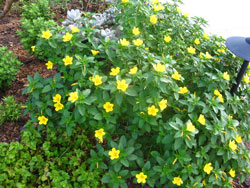Resource Library
Plant of the Week: Buttercup, Brazilian
The University of Arkansas System Division of Agriculture does not promote, support or recommend plants featured in "Plant of the Week." Please consult your local Extension office for plants suitable for your region.
Plant of the Week
Brazilian Buttercup
Latin: Turnera ulmifolia

Summer in the garden is a tough time for most plants. Whenever daily temperatures - the average over a 24-hour period - exceed 85 degrees, most plants begin to shut down. The ones that don’t close up shop in the heat and humidity of summer hail from the tropics. One that has stood up well in our gardens during periods of excessive summer heat is Turnera ulmifolia, a native of the West Indies that is now naturalized throughout much of tropical America.
Turnera goes by several common names, including Cuban (or Brazilian) Buttercup, Yellow Alder, or ramgoat dash-along - an inference that it increases the sexual libido of goats when they eat the foliage. It is a tropical shrubby perennial growing to 4 feet tall and wide but less than half that when grown as an annual. If given room and sunlight, it grows as a mounded, much-branched plant with woody basal stems and aromatic, fresh-looking, bright green leaves to 3 inches long.
The five-petaled flowers are bright yellow and to 2 inches across, slightly cup-shaped when open and generally resemble the blooms of a buttercup. The flowers are not fragrant and remain open only one day, but they are produced with abundance throughout the heat of summer and into the fall. The nectary at the base of the flower produces lots of sustenance, for the blossoms are under constant attack by bumblebees and butterflies. The fruit is a pea-sized capsule containing numerous seeds.
Turnera has been classified as belonging to its own small plant family. It is named in honor of William Turner (1508-1568), an English clergyman considered the father of English botany, because he translated an herbal of his day into English from its original Latin. The epitaph refers to the fact that the leaf somewhat resembles an elm.
Brazilian buttercup is an example of a plant that causes those responsible for identifying and banning invasive plants some heartburn. It is adaptable to a wide variety of growing conditions, and in nature it prefers disturbed sites. It is fast-growing and one of the first plants to pop into bloom after a hurricane. It is already widely distributed throughout the tropical world, partly because it is an attractive garden plant and so easy to grow. And it loves the heat, so when the heat really cranks up in the tropics this is one of the plants that can be relied upon to bloom.
Turnera was introduced to most gardeners in the temperate parts of the United States in the 1990s when Texas horticulturists got together and began promoting plants that would stand up to summer heat in their challenging climate. From that introduction it has crept into the plant trade and can now be found offered occasionally in local nurseries and big-box stores.
I’ve watched the plant for 15 years in northwest Arkansas and see no indication it is likely to become an established weed in this area. It will reseed, but the few scattered seedlings come up with the heat of summer, so they have little time to grow before being killed by frost. Only in the warmer parts of zone 9 will Turnera survive over winter. Turnera is similar to Lantana, another widely escaped weed in the tropics, and should pose no threat of escaping the bounds of the garden in colder parts of the country.
Brazilian buttercup should be planted in sunny areas of the garden after the soil has warmed in the spring. Once established, it has considerable drought tolerance. As a young plant it is compact and free-branching, so plant at least 18 inches apart if the intent is a mass planting. It also is well suited for use in mixed containers.
By: Gerald Klingaman, retired
Extension Horticulturist - Ornamentals
Extension News - October 8, 2010
The University of Arkansas System Division of Agriculture does not maintain lists of retail outlets where these plants can be purchased. Please check your local nursery or other retail outlets to ask about the availability of these plants for your growing area.